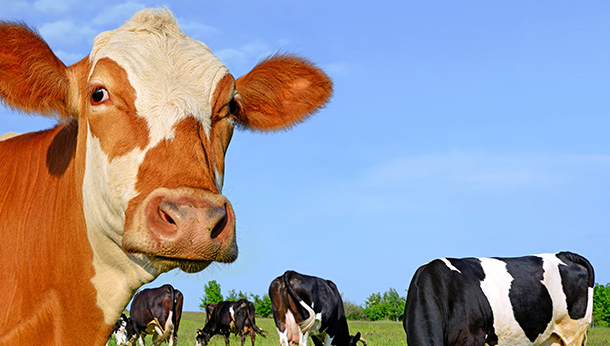
Bovine Viral Diarrhoea (BVD) is a highly contagious disease that costs the beef and dairy industries in excess of £33 million a year, but what is it and how can you make sure it doesn’t affect your animals or your bottom line?
What is BVD?
The virus itself is a pestivirus that is closely related to Border disease in sheep and Classical Swine fever in pigs.
How BVD affects the herd varies. Adults show signs of fever, lethargy, decreased milk production and diarrhoea. Foetal infection in utero can lead abortions, congenitally deformed calves that are weak and often die to persistently infected (PI) animals.
Due to the immunosuppressant nature of the disease, animals infected are more susceptible to other diseases like pneumonia and scour and links have been made to an increase in cases of TB in an infected herd.
The biggest issue is the impact BVD has on reproduction. Infertility, foetal absorption, mummification of the foetus, congenital defects of the eyes and nervous system and weak and premature calves are all markers of BVD.
The virus is perpetuated within the herd by animals that are Persistently Infected (PI) with BVD.
PIs
If cows or heifers become infected within the first 120 days of pregnancy, the unborn calf can be born with the disease and will be a Persistently Infected animal.
If the dam becomes infected early in the gestation period (before day 110) the underdeveloped immune system of the unborn calf doesn’t recognise the virus as foreign. The animal incorporates it into its immune system and carries the virus for life.
Once born, these calves often show no signs of the disease but become super-shedders. They shed millions of virus particles in their skin, saliva, urine and faeces which then spreads rapidly throughout the herd. A single PI in a calf pen can spread disease to the rest of the herd.
The damage a PI can cause could end up costing farmers a fortune in infertility issues, high abortion rates, loss of productivity, outbreaks of scour and pneumonia.
Some of the PI youngsters can develop Mucosal Disease when they become infected with a more aggressive strain of BVD resulting in fevers, ulceration of the nose, mouth and feet, severe diarrhoea and eventually death. Some PI animals go on to become breeding cows but will always give birth to a PI calf perpetuating infection in a herd.
How is it Spread?
If you already have a PI in your herd, the virus can be spread by nose-to-nose contact, saliva, urine, faeces etc. The disease is maintained within a herd by a PI. There are tests available that can help identify a PI or an infected animal. Speak to your vet about arranging these tests.
Bought-in animals are also one of the biggest risks. They can be PIs or simply infected, causing the disease to spread within your existing herd. Speak to your vet about testing these animals before introducing them.
Contact with neighbouring cattle across fences may also cause a biosecurity issue as well as contact through markets and a shared or hired bull. An infected bull can spread the disease through its semen.
In the German eradication programme, it was found that visitors to farms were spreading the disease from farm to farm, highlighting the importance of washing and disinfecting facilities for visitors.
Control
A committed vet and farmer make a formidable team in the fight to eradicate BVD. The ADAM acronym sets out the four steps that will help you achieve a BVD free status.
A – Assess
Assess your herd for PIs and disease risk, including the environment your herd is kept in, neighbouring cattle etc., anywhere that your cattle could come into contact with the disease.
D – Define
Define the status of your herd with testing.
A – Action
Create and implement an action plan for the control of BVD on your farm.
M – Monitor
Monitor your herd, revisit steps 1 and 2 regularly to ensure your cattle stay BVD free.
The lynch pin to control is making sure you identify and cull any PIs in your herd and then follow that up with a vaccination strategy for the remaining animals.
Your vet can help you identify the PIs and can advise on various vaccine options. Discuss what will work best for you and your herd with your vet to make sure your herd is, and stays, BVD free.
Other European countries have implemented control and eradication schemes, with quite a bit more success than the UK. Norway, Sweden, Finland and Denmark are now virtually BVD free.
There is also a voluntary, industry-led initiative to help eradicate BVD from England by 2022. The scheme offers a database of BVD free farms and individual animals, information on BVD control and the latest news. Take a look at the website.
Getting BVD under control and eradicating it is important for any farm, whether they are disease free or not. Even if a herd is uninfected, it needs protection, as introduction of BVD into a herd that has not been previously exposed could be disastrous for herd health as well as financially for the farm.
There is some good news though. As more herds become clear of infection, protection becomes easier as the risks of infection reduce.